For New Zealand’s Tūhoe Māori people, a spectularly sustainable building serves as the first tribal headquarters in 1.5 centuries. Here, nature, custom and community come to flourish in harmony.
When a crowd of 3,000 people moved as one to the sound of Tūhoe Māori warriors calling them, you could have mistaken it for a scene in a movie. Against the spectacular backdrop of a pure timber cladded building, adorned with a large array of solar panels, the visitors from far and wide moved respectfully slow towards the amphitheatre shaped atea (grass courtyard) on the north side of the building. Facing two gigantic panels of exterior artwork depicting the mana motuhake (self-determination) philosophy of the Tūhoe people, the crowd was given a spectacular traditional welcome that comprised ceremonial haka (war dance) and waiata (traditional song). Where did this welcome take place? The crowd was greeted at the entrance of Aoteroa New Zealand’s first fully certified Living Building: Te Uru Taumatua (TUT), erected in Tāneatua, New Zealand.
“It was amazing. The people around you were all feeling the same, so you kind of took in the exciting energy. It was a feeling of hope, a feeling of new things to come,” says Maea Rurehe. He is the young receptionist of the building that serves as Tūhoe’s first tribal headquarters in 150 years.
-
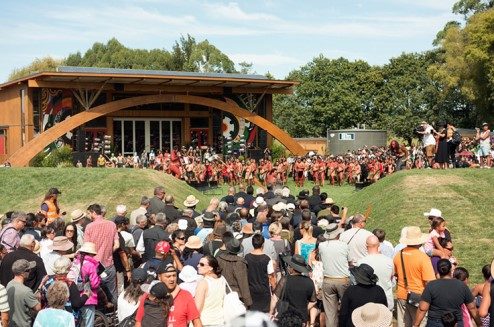 © Foto (CC BY-NC-ND): Lottie Hedley
© Foto (CC BY-NC-ND): Lottie Hedley
-
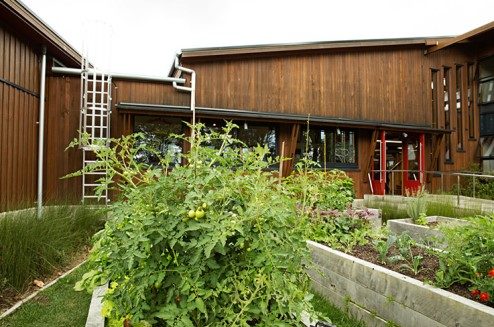 © Foto (CC BY-NC-ND): Lottie Hedley
© Foto (CC BY-NC-ND): Lottie Hedley
-
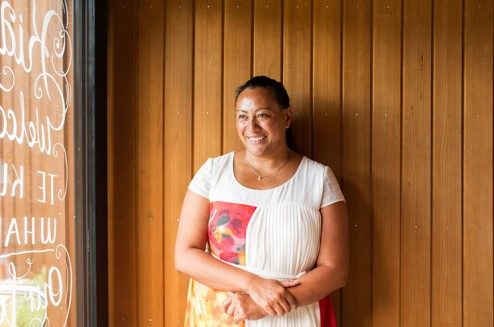 © Foto (CC BY-NC-ND): Lottie Hedley
© Foto (CC BY-NC-ND): Lottie Hedley
-
 © Foto (CC BY-NC-ND): Lottie Hedley
© Foto (CC BY-NC-ND): Lottie Hedley
-
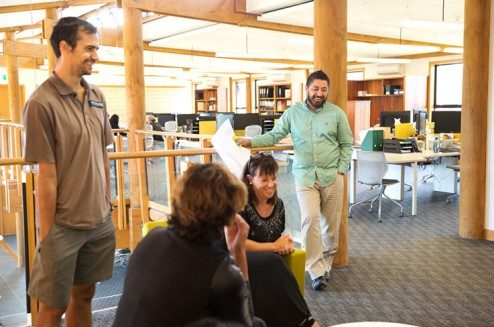 © Foto (CC BY-NC-ND): Lottie Hedley
© Foto (CC BY-NC-ND): Lottie Hedley
-
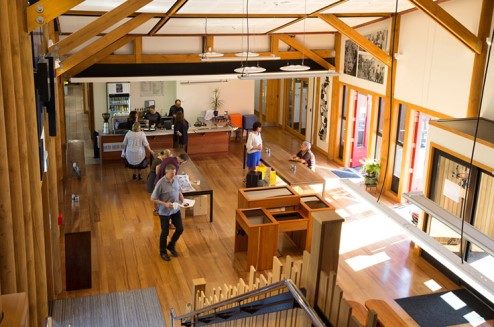 © Foto (CC BY-NC-ND): Lottie Hedley
© Foto (CC BY-NC-ND): Lottie Hedley
-
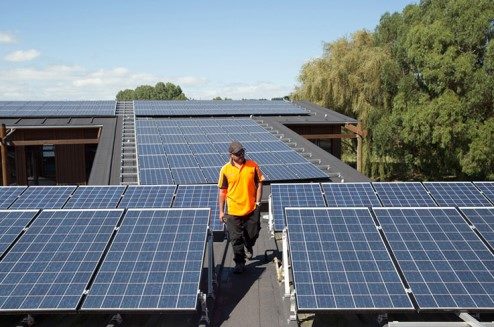 © Foto (CC BY-NC-ND): Lottie Hedley
© Foto (CC BY-NC-ND): Lottie Hedley
-
 © Foto (CC BY-NC-ND): Lottie Hedley
© Foto (CC BY-NC-ND): Lottie Hedley
-
 © Foto (CC BY-NC-ND): Lottie Hedley
© Foto (CC BY-NC-ND): Lottie Hedley
-
 © Foto (CC BY-NC-ND): Lottie Hedley
© Foto (CC BY-NC-ND): Lottie Hedley
Opened in 2014, after achieving a historic settlement with the New Zealand government, the building reflects Tūhoe’s deep engrained belief that people and nature are part of the same system, reliant upon each other and requiring us to be very respectful of our resources. A traditional Māori proverb further illustrates Tūhoe’s integrity to their tikanga (customs):
Ko te whenua te toto o te tangata
Ko te tangata te kanohio of te whenua
The land is the blood of the people
The people are the face of the land
A complex structure with deep meaning
Legendary New Zealand architect Ivan Mercep (1930-2014) and his team understood the holistic approach to sustainability that Tūhoe expected. They suggested to design the multi-purpose building in accordance with the International Living Future Institute’s Living Building Challenge (LBC).
Much more stringent than any other green building standards in the world, the LBC is a sustainability certification programme that is designed around seven performance areas made up of 20 imperatives. To earn ‘Living’ status (full programme certification), projects must meet all assigned Imperatives, including net zero energy, water and waste. Furthermore, they must have proven performance through at least 12 consecutive months of operation.
For receptionist Rurehe, the sharing of knowledge and insights from profound people and the high ambitions to succeed and create a complex structure with deep meaning is what makes Te Uru Taumatua so inspiring. He takes great pride in showing
manuhiri (visitors) around the building, encouraging them to “…look inside ourselves and outside the box and re-evaluate the way we live so that we may explore a better and sustainable future.”
A cultural hub in conversation with nature
As manuhiri walk across 100-year-old Matai (native timber) flooring to enter into the large community tribal chamber, Rurehe shares his insight into Tūhoe’s visionary 40-year blueprint, conceived for Tūhoe to become an independent nation. Te Uru Taumatua’s two-story administrative wing serves as the hub of ideas, policies and implementation of this vision across units dedicated to Tūhoe people, biosphere, infrastructure, resources and future.
Linking the two major spaces of the building is the sun-flooded reception area with access to a small Tūhoe library and archive as well as an open-plan cafe that serves local food.
Small gardens and an orchard on the Western side of the building provide fruit, greens and herbs for the cafe. Plans are in place for further planting that will one day see the building in conversation with a surrounding forested glade alive with native flora.
Making value come alive
For Kirsti Luke, CEO of Te Uru Taumatua, sustainability in the Tūhoe sense has got to do with people. Therefore, it was important that the building process included training and employing their people every step of the way as well as sourcing as many building materials as possible from within Te Urewera. “The building exposes the value that is alive in the communities,” Luke says. “The talents of people in the community who had discredited their worth for lack of qualification turned up with natural instinct for values and principle, for foresight, for courage, for hard work, for team work.”
Tūhoe across the rohe (region) spent weeks recovering down and dead native trees from local forests and rivers. They were then milled on site and used for cladding, flooring and furniture. Clay extracted from land throughout Te Urewera was transformed into handmade earth-bricks for internal walls in a hugely successful community effort.
A group of Tūhoe people led this process and taught groups of volunteers to create 5,000 bricks. Samantha McGavock, who was the construction sustainability manager for the project and guided the community efforts, says that close to 200 people ended up being involved in creating the bricks. “There were grandmothers with their grandsons, school kids and business groups – it was a very challenging but also a very special and unique process,” McGavock says.
The continuity of time, genealogy and culture
For Rurehe, who worked nightshifts at a supermarket in a neighbouring town before landing the job as TUT’s receptionist, the building has been an inspiration to seek a sustainable way to build his own first home for his small family. “The building is proof that Tūhoe ideas and goals are possible to achieve.”
As the crowd of 3,000 people surrounded the impressive 23-metre timber arch that spans the front entrance of the building beautifully, you would be glad to know that the scene was indeed captured in a movie. Ever the Land, the award-winning feature documentary that charts the inspiring architectural journey and historic settlement of the Tūhoe people, at some point frames the arch lit at night after the celebratory opening.
Shaped in the path of the rising and setting sun, the arch is a design relating directly to the Tūhoe Te Mana Motuhake flag that is synonymous with the tribe’s historic claim to self-determination. For Tūhoe, the arch symbolises the continuity of time, whakapapa (genealogy) and culture. It is a reminder of where they’ve come from and where they are going. Essentially Tūhoe, sustainability leads the way.
